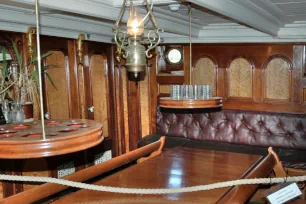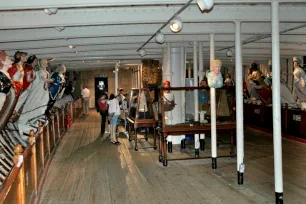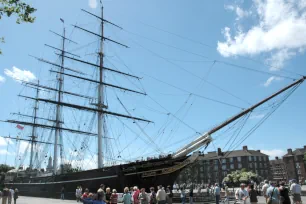The Cutty Sark is a historic clipper that was one of the fasted ships of its time. Today it sits in dry dock at Greenwich in London. After a fire almost destroyed the ship in 2007, it was painstakingly restored to its former splendor.



The last clipper ship to be built as a merchant vessel, the Cutty Sark was completed in 1869. It is the only remaining tea clipper ship from the nineteenth century.
It is said that the name of the ship comes from a Robert Burns comic poem, in which a beautiful witch is described as wearing a cutty sark, a Scottish term referring to a short chemise. The figurehead on the Cutty Sark would represent this witch.
History of the Ship
The ship was constructed in Dunbarton, England, for Captain “Jock” Willis. It was designed by Hercules Linton, a well-known ship architect of that era. The ship has a composite wrought iron frame structure covered by wooden planking and weighs 921 tons. It is 65 meters (212 feet) long.
Clipper Races



At the time Cutty Sark was built, the tea trade between China and London was at its peak and the ship was meant to be quick so that Willis could beat his competitors across the ocean. In 1871, it won the yearly clipper competition from China to London in 107 days.
However, the Cutty Sark didn’t always win. Its most famous race was against the Thermopylae the next year, in 1872. The two ships left from Shanghai on the same day, but Cutty Sark lost its rudder in the middle of the journey. However, the captain continued the trip and arrived only a week after the Thermopylae. It was that race that gave the famous ship its reputation as a hearty vessel.
Restoration
The ship was later sold to a Portuguese company, and in 1895 the Cutty Sark became the Ferreira. She was sold again twenty years later and renamed the Maria do Amparo. However, Wilfred Dowman, a retired shipowner who had witnessed the Cutty Sark outpacing a steamship, was determined to bring the ship back to its native land. He purchased the Cutty Sark in 1922 and restored it. After his death, the Cutty Sark was used as a training ship for more than two decades. In 1954, the ship was moved into dry dock, where she remains today. It opened to the public three years later.
A Museum Ship
Visitors to the Cutty Sark in Greenwich can now enjoy the ship’s status as a museum ship. Tended by the Cutty Sark Trust, the vessel is a wonderful testament to the fine ship building of the nineteenth century and attracts tons of visitors who can get an idea of what life must have been on board of a clipper ship. There is also a unique collection of more than eighty ships’ figureheads on display at the museum.

Fire damage and Restoration
The ship suffered a devastating fire in May 2007 during restoration, though some of it was spared because important parts had been taken off-site for repairs. After a five-year-long, £50 million restoration project, the nineteenth-century museum ship was reopened again on April 25, 2012, by Queen Elisabeth II. The site was also modernized, and the ship was raised more than three meters (11ft) into the air, allowing visitors to walk under the hull of the ship.

